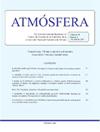Distribution and spatio-temporal variation of temperature and precipitation in the Sierra de Otontepec Ecological Reserve, Veracruz, Mexico through GIS modelling
IF 1
4区 地球科学
Q4 METEOROLOGY & ATMOSPHERIC SCIENCES
引用次数: 1
Abstract
Sierra de Otontepec Ecological Reserve is an isolated mountain in the Coastal Plain of Gulf of Mexico with great scientific importance. However, it lacks climatological information to support the studies of the ecosystems that have been carried out in recent years. Through GIS modelling its climatology was characterized, and climate variability scenarios were created for the period 1981-2010. From temperature and precipitation data recorded in situ, vertical gradients of both variables were obtained in relation to the orography of the zone. The records were correlated with data from nearby weather stations so that by using a DEM it was possible to obtain raster layers with a resolution of 15 m per pixel for temperature, in the summer and winter seasons; and for precipitation, in the rainy and dry seasons; the annual value was also calculated for both variables. The climatic variability detected in the zone indicates a gradual increase in air temperature over time and a spatial variation in the distribution of precipitation. The spatial resolution of the modelling is precisely adjusted to the relief of the mountain, allowing the flora and fauna elements found within each pixel to be analysed with a good level of detail. This work represents the most viable and effective alternative to estimate temperature and precipitation values in mountain systems lacking climatological stations; demonstrating that beyond providing climate information, which is increasingly necessary for ecosystems, it is possible to model their spatio-temporal dynamics to better understand the complex climate variability of our days.基于GIS模型的墨西哥韦拉克鲁斯州Sierra de Otontepec生态保护区温度和降水分布及时空变化
Sierra de Otontepec生态保护区是墨西哥湾沿岸平原上一座孤立的山脉,具有重要的科学意义。然而,它缺乏气候信息来支持近年来进行的生态系统研究。通过GIS建模对其气候学进行了表征,并建立了1981—2010年的气候变率情景。从现场记录的温度和降水资料中,得到了这两个变量与该地区地形的垂直梯度。这些记录与附近气象站的数据相关联,因此通过使用DEM,可以在夏季和冬季获得分辨率为每像素15米的温度栅格层;对于降水,在雨季和旱季;还计算了这两个变量的年值。观测到的气候变率表明气温随时间逐渐升高,降水分布存在空间差异。模型的空间分辨率精确地调整到山的浮雕,允许在每个像素内发现的动植物元素进行良好的细节分析。这项工作代表了在缺乏气象站的山区系统中估计温度和降水值的最可行和有效的替代方法;这表明,除了提供对生态系统越来越必要的气候信息之外,还可以对生态系统的时空动态进行建模,以更好地了解当今复杂的气候变化。
本文章由计算机程序翻译,如有差异,请以英文原文为准。
求助全文
约1分钟内获得全文
求助全文
来源期刊

Atmosfera
地学-气象与大气科学
CiteScore
2.20
自引率
0.00%
发文量
46
审稿时长
6 months
期刊介绍:
ATMÓSFERA seeks contributions on theoretical, basic, empirical and applied research in all the areas of atmospheric sciences, with emphasis on meteorology, climatology, aeronomy, physics, chemistry, and aerobiology. Interdisciplinary contributions are also accepted; especially those related with oceanography, hydrology, climate variability and change, ecology, forestry, glaciology, agriculture, environmental pollution, and other topics related to economy and society as they are affected by atmospheric hazards.
 求助内容:
求助内容: 应助结果提醒方式:
应助结果提醒方式:


